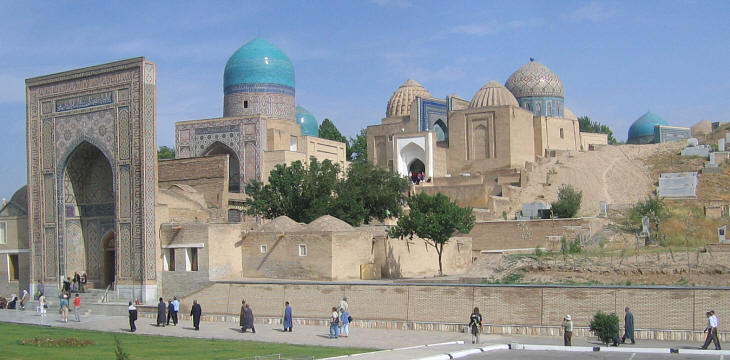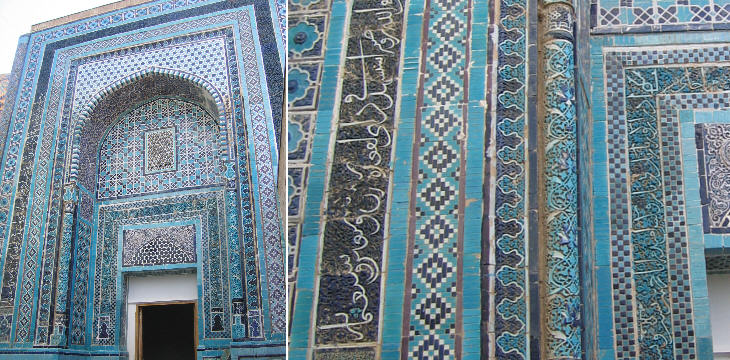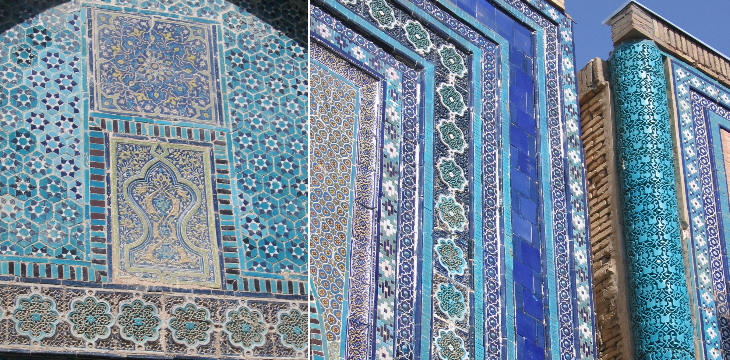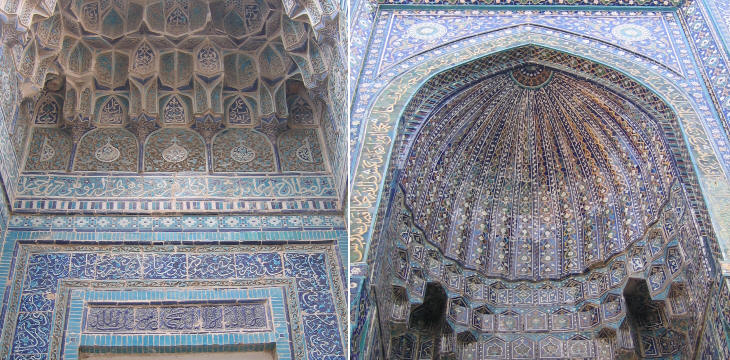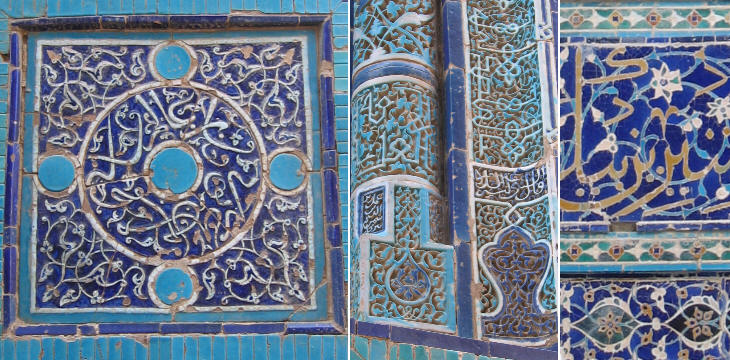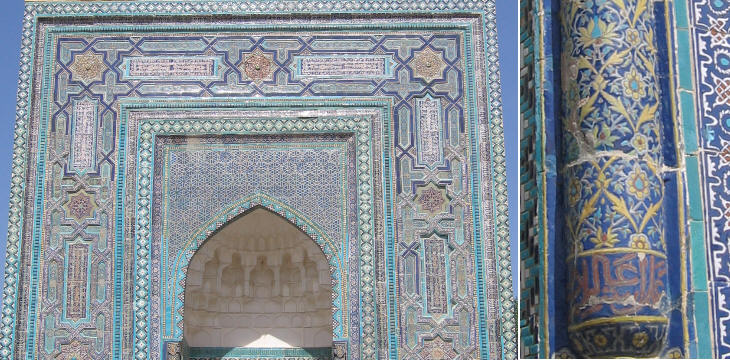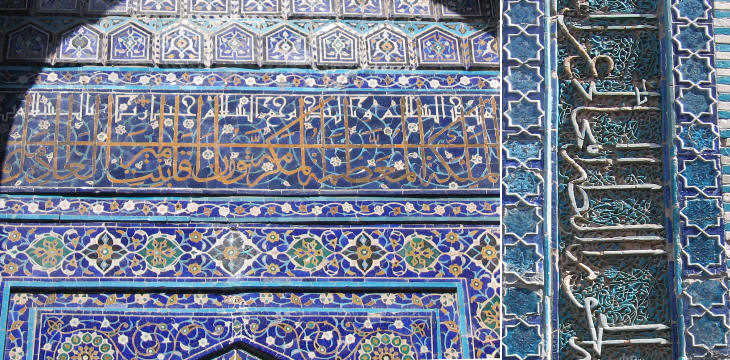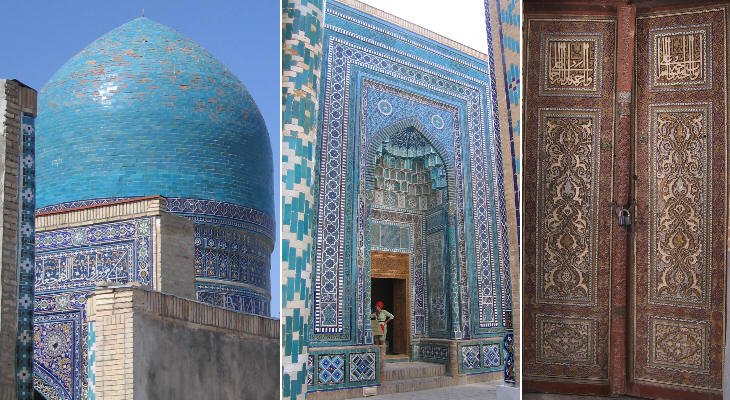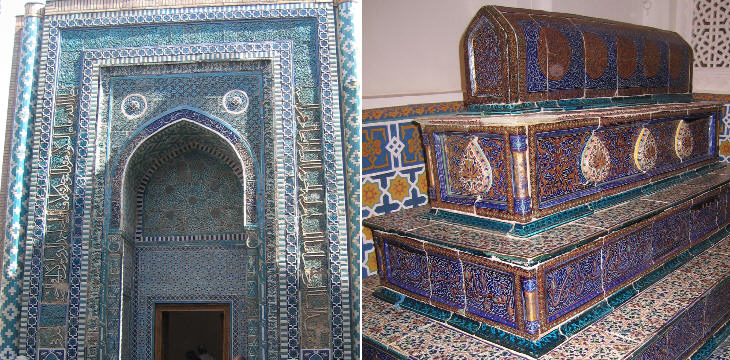  What's New! Detailed Sitemap All images © by Roberto Piperno, owner of the domain. Write to romapip@quipo.it. Text edited by Rosamie Moore. |
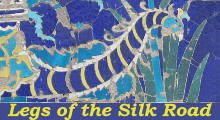 - Samarkand - page two: Shah-e Zinda - Samarkand - page two: Shah-e Zinda(detail of a decoration at Abdoul Aziz Khan Medrese in Bukhara) According to tradition Koussam-ibn-Abbas, a first cousin of Prophet Muhammad, brought Islam to the region. He convinced the inhabitants of Samarkand not by the sword, but by his holy deeds. One day when he was very old he descended into a well which is thought to be the entrance of an underground palace where he is still alive.
In the following centuries the fame of Koussam-ibn-Abbas led to the construction of a mosque and of a mausoleum on the site where he disappeared. The name of the site (a small hill) bears a reference to this account: the Living King. Ordinary residences and businesses were relocated from the hill and tombs were built around that of Koussam. In 1434-35 Ouloug Beg, grandson of Timur, built a gigantic portal at the foot of the hill and a series of terraces which made the access to the necropolis easier. Unlike the medreses of Registan (page one) or the mosque of Bibi Khanoum (page three), the mausoleums of Shah-e Zinda, owing to their smaller size were not extensively damaged by earthquakes and other factors, yet an excessive restoration has weakened the evocativeness of the site.
First erected tombs cluster around the mausoleum at the top of the hill and later structures descend the southern slope in a long string. The site received increased attention in the fourteenth century and Timur buried many of his female family members here. The decoration is mainly based on glazed tiles; their colours span over all tones of blue.
An unknown emir built the so called Emir Zade Mausoleum. The portal in addition to tiles is decorated with reliefs and carved glazed terracotta. Chadi Moulk Aka is the first mausoleum built during reign of Timur. An inscription on the portal notes in Arabic that Turkan Aqa (Timur's older sister) built this well preserved mausoleum for her daughter Chadi Moulk who died in December 1371.
A precious pearl was lost here is the mourning epitaph dictated by Turkan Aqa for her daughter. Chirin Bika Ata was another sister of Timur; her mausoleum was built at a later date and its decoration shows the hand of artisans from Tabriz, a town in western Persia, known for its tiles. Also the deep muqarna (niche) of the portal marks a change from previous patterns.
Tiles with reliefs, carved terracottas, majolica mosaics show the variety of techniques used to enrich the decoration.
The mausoleums were built on both sides of a very narrow passage which actually did not allow the viewer to properly observe their design and decoration. In the central part of the necropolis some buildings have fallen, thus allowing a better view of the remaining mausoleums. Strangely enough, considering the large use of inscriptions as a decorative pattern, the names of the people buried in these mausoleums are unknown.
Alim Nasafi was the architect of this mausoleum; the inscriptions he placed in various points of the portal were not exclusively praising Allah and his Prophet; they included sentences such as: There is true friendship only in dreams and There is nothing man can build, which is not going to vanish.
One of the finest mausoleums was built for Touman Aka, Timur's youngest wife; the inscription above the entrance is a Memento Mori, as it reminds that the tomb is a gate that everyone will enter. The mausoleum of Khodja Akhmad is among the oldest ones and it provided a pattern for those which were built later. The portal is surrounded by a gigantic inscription; similar inscriptions can be seen on the portals of many Seljuk medreses.
Koutloug Aka was another of Timur's wives and she was buried in a mausoleum facing that of Touman Aka; these mausoleums were preceded by a 1495 tchortak, a small portico open on both sides. Here a very finely decorated door leads to the mausoleum where Koussam-Ibn-Abbas is buried (although this contradicts the traditional account which says that he is still alive).
PS: the names of Uzbek locations and people are transliterated into western languages in a variety of ways. This is because the original Arab alphabet was replaced by the Cyrillic one which very recently has been replaced by the Roman alphabet. To give an example an alternative English spelling of Shah-e Zinda is Chah-I-Zinda. Go to Samarkand - page one or to Samarkand - page three Introductory page Bukhara Khiva Chakhrisabz  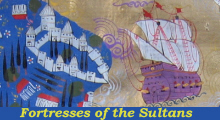  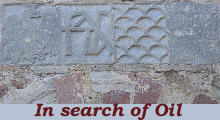 |
